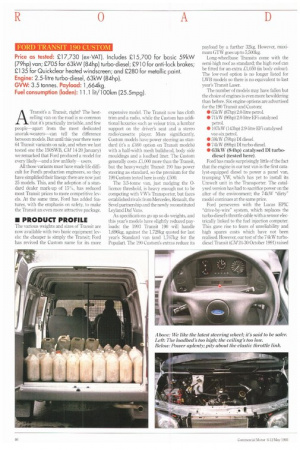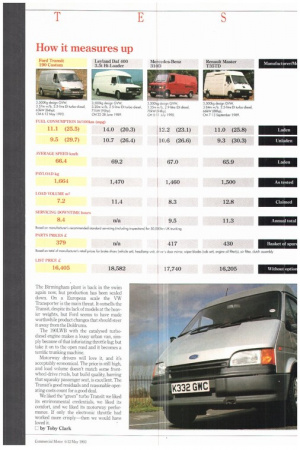Price as tested: 217,730 (ex - VAT). Includes £15,700 for basic 59kW
Page 48

Page 49

Page 50

Page 51

If you've noticed an error in this article please click here to report it so we can fix it.
(79hp) van; £705 for 63kW (84hp) turbo-diesel; 2910 for anti-lock brakes, £1 35 for Quickclear heated windscreen; and 2280 for metallic paint. Engine: 2,5-litre turbo-diesel, 63kW (84hp).
GVIN: 3.5 tonnes. Payload: 1,664kg.
Fuel consumption (laden): 11.1 lit/100km (25.5mpg).
ATransit's a Transit, right? The bestselling van on the road is so common that it's practically invisible, and few people—apart from the most dedicated anorak-wearers—can tell the difference between models. But until this year there were 64 Transit variants on sale, and when we last tested one (the 150SW13, CM 14-20 January) we remarked that Ford produced a model for every likely—and a few unlikely -users.
All those variants must have made life difficult for Ford's production engineers, so they have simplified their lineup: there are now just 25 models. This, and the adoption of a standard dealer mark-up of 15%, has reduced most Transit prices to more competitive levels. At the same time, Ford has added features, with the emphasis on safety. to make the Transit an even more attractive package.
• PRODUCT PROFILE
The various weights and sizes of Transit are now available with two basic equipment levels: the cheaper is simply the Transit; Ford has revived the Custom name for its more expensive model. The Transit now has cloth trim and a radiu, while the Custom has additional luxuries such as velour trim, a lumbar support on the driver's seat and a stereo radio/cassette player. More significantly, Custom models have power steering as standard (it's a £460 option on Transit models) with a half-width mesh bulkhead, body side mouldings and a loadbed liner. The Custom generally costs 1:1.000 more than the Transit, but the heavyweight Transit 190 has power steering as standard, so the premium for the 190 Custom tested here is only J.:500.
The 3.5-tonne van, just nudging the 0licence threshold, is heavy enough not to be competing with VW's Transporter, but faces established rivals from Mercedes, Renault, the Sevel partnership and the newly reconstituted Leyland Oaf Vans.
As specifications go up so do weights, and this year's models have slightly reduced payloads: the 1993 Transit 190 will handle 1,696kg, against the 1,729kg quoted for last year's Standard van (and 1,767kg for the Popular). The 190 Custom's extras reduce its payload by a further 32kg. However, maximum GTW goes up to 5,500kg.
Long-wheelbase Transits come with the semi-high roof as standard; the high roof can be fitted for an extra £1,050 (in body colour). The low-roof option is no longer listed for LI,VB models so there is no equivalent to last year's Transit Laser.
The number of models may have fallen but the choice of engines is even more bewildering than before. Six engine options are advertised for the 190 Transit and Custom: • 65kW (87hp) 2.0-litre petrol.
• 71kW (96hp) EFi catalysed petrol.
• 107kW (143hp) 2.9-litre EFi catalysed vee-six petrol.
• 59kW (79hp) DI diesel.
• 74kW (99hp) DI turbo-diesel.
• 63kW (84hp) catalysed DI turbodiesel (tested here).
Ford has made surprisingly little of the fact that the engine in our test van is the first catalyst-equipped diesel to power a panel van, trumping VW, which has yet to install its Umwelt unit in the Transporter. The catalysed version has had to sacrifice power on the alter of the environment; the 74kW "dirty" model continues at the same price.
Ford perseveres with the Lucas EPIC "drive-by-wire" system, which replaces the turbo-diesel's throttle cable with a sensor electrically linked to the fuel injection computer. This gave rise to fears of unreliability and high spares costs which have not been realised. However, our test of the 74kW turbodiesel Transit (CM24-30 October 1991) raised the problem of slow throttle response. Has this been cured?
Today's big issue in the car market is safety, and Ford hopes to claim the high ground in this area of the van market: it has introduced the HIC (Head Impact Criteria) steering wheel; seat belt "grabbers" and an "anti-submanning" squab on the driver's seat—which the catalogue worryingly refers to as an "antisubmarine seat". The next facelift will probably see the introduction of side impact bars and a driver's airbag (if not sonar, torpedoes and depth charges).
Despite the rationalisation of the Transit range there has been little reduction in the variety available: if a basic model doesn't suit you, your dealer will gladly steer you towards the comprehensive options list --or the even more lengthy Special Vehicle Operations (SVO) list.
• PRODUCTIVITY
With its bulk and its silver finish our test van had a rather Zeppelin-like appearance, or perhaps a British airship would be more appropriate. But is the 190 Custom a graceful R100 or an ill-fated R 01?
The 190's 1,661kg payload is good in the 3.5-tonne class, beaten only by the biggest Sevel vans, arid had tolerance is a respectable 300kg, but heavy loads should be biased towards the 2,200kg rear axle (the turbocharger installation adds nothing to the quoted kerbweight). The Transit is as easy to load as an wheel-drive van: the doors open easily a load space is wide and flat. The spare doesn't intrude, being slung undernea body, and the jack and wheelbrace are stowed behind a side panel.
The load space is not high enough to up in, so loading can be a pain in the n the optional high roof adds a healthy 3E to let six-footers stand tall. It also adds to load volume (by the VDA measure), would make it competitive with the Ii the Ducat° Maxi and Mercedes 310D bi quite a way down on the Renault and LA Daf competition.
Users may think twice before specif; diesel engine—the basic naturally asp 59kW diesel costs £1,840 more than the 65kW petrol unit, with a further £705 for either the 63kW or 74kW turbo-diesel. Even the 2.9-litre vee-six costs almost £1,000 less than the basic diesel.
Fortunately the turbo unit offers a good average speed—it covered our Kent route at 66.4km/h—with excellent fuel consumption figures of 11.11it/100km laden and 9.51itJ100km unladen. These compete strongly with the class leaders from Sevel and Renault. The catalysed engine's economy is on a par with that of the more powerful turbodiesel, and judging by its acceleration and hill-climb times it loses nothing in practical performance. If brand image counts as part of a vehicle's productivity, the Transit scores highly; it looks sleek and solid and the Moondust Silver finish of our test vehicle was widely praised. It is unusual for a test vehicle especially a Transit—to attract such comment.
• ON THE ROAD
The broad-beamed Transit's handling is stable and reassuring at all speeds, suffering little from crosswinds, while the power steering allows easy, precise manoeuvring. Gearchanges are as painless as one expects from a Ford, and the ABS-equipped brakes operate firmly and progressively.
The diesel starts easily every time and, for a DI unit, idles quietly; with a few more revs the turbo starts to whoosh and the torque begins to flow. It's an impressively strong engine throughout the rev range, but the electronic control system is far from perfect.
When Ford removed the accelerator cable, they might as well have replaced it with an elastic band.
The slight delay on acceleration makes stop-start town driving hard work: the driver puts his foot down, feels nothing, puts his foot down further and is rewarded with a sudden surge of turbo power and wheelspin. It's not easy to get used to, and serves as a poor advertisement for the advantages of electronic control.
Having said that, the Transit allows superb, stable, fast motorway cruising, with plenty of power in reserve for overtaking (allowing for that slight lag). The turbo unit certainly produces excellent low-end torque—more than the naturally-aspirated unit, and at lower revs. Sometimes, it seems, you really can have your cake and eat it.
• CAB COMFORT
The Transit's cab is light and airy, with deep side windows and good headroom. The velour trim of the Custom is attractive and comfortable, while the seat is exemplary: the combination of good ride quality and a superb driving position will sell the van straight away for many users.
Noise levels are acceptable, even without a bulkhead. The turbo certainly seems to absorb the DI diesel's clatter: noise figures at 96km/h are 2.8dB(A) lower than those of the 150SWB, which made up in sound volume what it lacked in load volume. The most irritating noise is the passenger seat's squeak when occupied; a problem we also found with the earlier test vehicle.
Ford seems to change the Transit's steering wheel at every facelift, and the previous design didn't last long, but the chunky HIC wheel could be the best yet The rain-deflecting "ears" on the door mirrors seem to work at motorway speeds, but we would like to see heated mirrors on the options list. Slightly deeper mirrors would also be appreciated as a parking aid.
The large side windows help visibility, but sunny days can produce a greenhouse effect in the cab, and the sunblinds won't pivot to the side. The heating system is effective but the Transit is still not equipped with central air vents and the heater controls are poorly illuminated.
Stowage space in the cab is adequate rather than exceptional, and the glovebox is still not lockable, but we can't complain: overall the Transit has one of the most comfortable and appealing driving environments available in a light commercial.
• SUMMARY
Ford must have breathed a sigh of relief when Leyland Daf hit stormy waters—UK sales of the ageing 200 and 400 Series had been accelerating, helped by keen pricing and generous specifications. The Birmingham plant is back in the swim again now, but production has been scaled down. On a European scale the VW Transporter is the main threat. It outsells the Transit, despite its lack of models at the heavier weights, but Ford seems to have made worthwhile product changes that should steer it away from the Doldrums.
The 190LWB with the catalysed turbodiesel engine makes a lousy urban van, simply because of that infuriating throttle lag; but take it on to the open road and it becomes a terrific trunking machine.
Motorway drivers will love it, and it's acceptably economical. The price is still high, and load volume doesn't match some frontwheel-drive rivals, but build quality, barring that squeaky passenger seat, is excellent. The Transit's good residuals and reasonable operating costs count bra good deal.
We liked the "green" turbo Transit we liked its environmental credentials, we liked its comfort, and we liked its motorway performance. If only the electronic throttle had worked more crisply-then we would have loved it.
C by Toby Clark
























































































